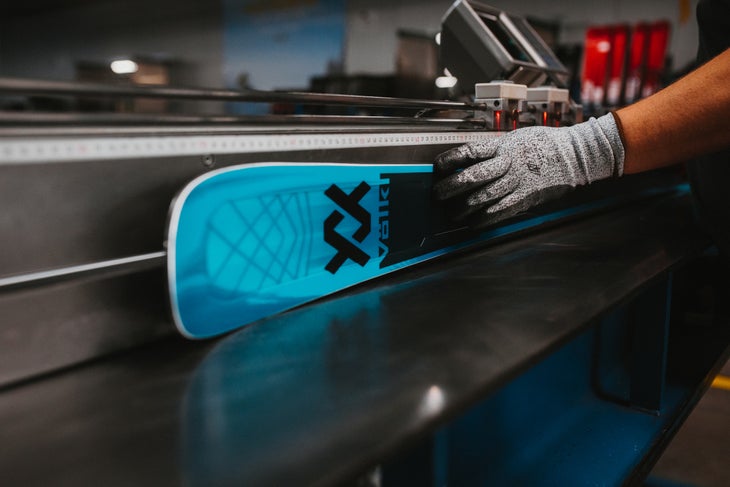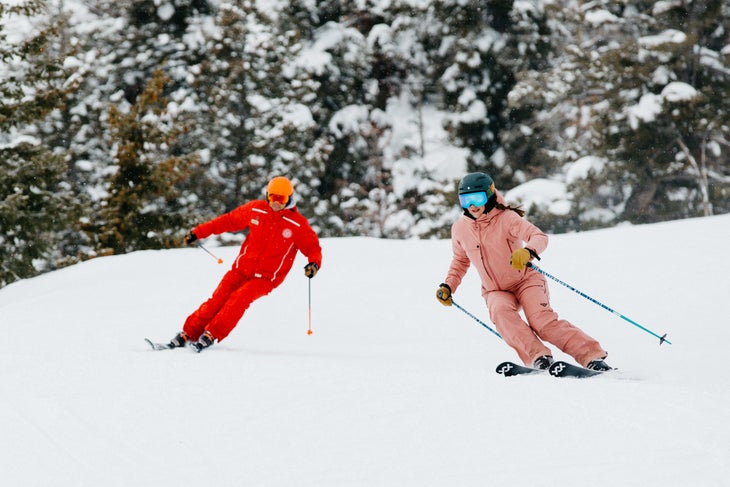Products You May Like
There’s a reason they say don’t fix what ain’t broke. When you mess with something as beloved as the Völkl Kendo 88 and its female counterpart, the Kenja 88, you risk ruining a good thing and ticking a lot of skiers off. But Völkl went ahead and tinkered with the award-winning Kendo anyway.
“We are always trying to be ahead of the crowd,” says Völkl Global Product Manager Andreas Mann. “We always have ideas about what could be improved. New technologies, materials, and industrial processes open new opportunities to reach new goals.”
We’re happy to report that the risk paid off. The Kendo that’s coming down the pike for 22/23 is better than ever, and that’s not just hyperbole. Take it from me, one of the few skiers on the planet who was never infatuated with the previous models of the Kendo.
I gravitate towards skis that hum with energy and are so quick and responsive that they will initiate a turn before you’ve even thought to issue the command. Compared to those skis, the Kendos and Kenjas of the past felt stiff, planky, and a little dead beneath my feet. They were stable and dependable as all get out, especially on hard snow, but they had no real personality. You stood on them and you allowed them to pull you into a medium-sized arc because that’s all they wanted to do, even after Völkl integrated its 3D Radius technology. You could get them to ski short turns and navigate moguls and tight terrain, but it took some serious willpower, skill, and strength. I just felt they were too much work, on and off the groomers.
Related: If you prefer playful planks over stiff boards, these 10 all-mountain skis are for you
But the new 22/23 Kendo is different. “The main focus for the new Kendo/Kenja was primarily to increase agility and pop on the groomers and improve handling beyond groomed slopes,” Mann explains. Mission accomplished, because the new Kendo is indeed livelier, snappier, quicker, and more fun not just on the groomers, but everywhere on the mountain thanks to big improvements to the ski’s technologies and construction.
What’s new in the 22/23 Völkl Kendo and Kenja?

The new Kendo and Kenja are actually the same ski—the women’s Kenja features the exact same construction and technologies as her brother but scaled down to women’s-appropriate lengths. So for the sake of simplicity, I’ll just reference the Kendo from here on out.
The old version of the Kendo featured the same Titanal Frame design across all ski lengths, meaning that whether you skied the Kendo in a 163cm or 184cm length, you were on a ski with the same width of Titanal framing the edges of the ski. This meant that shorter skiers on the 163cm Kendo were forced to ski a much stiffer ski relative to the ski’s length.
In the new version, Völkl incorporates its Tailored Titanal Frame first introduced in the Mantra and Secret in 2020/21 to correct that stiffness issue. In the 22/23 Kendo, the width of the upper Titanal layer is adjusted to the length of each ski length, tailoring the damping and torsional stiffness properties of the Titanal appropriately to the skier’s physique. The longer models of the Kendo will now feature a wider upper layer of Titanal above the sidewall in the shovel and tail area of the ski, whereas the shorter models will feature a slimmer layer, reducing the amount of Titanal in those areas.
Watch: A quirky but amazingly helpful explanation of Völkl’s Tailored Titanal Frame tech
That’s the first—and probably the most significant—technology update to the new Kendo. The next is a shorter center radius. While the previous Kendo model already featured Völkl’s 3D Radius Sidecut, which gave the ski three distinct turning radii in the front, middle, and back of the ski to allow skiers to switch up their turn shapes more easily, the old Kendo still preferred to lock into a medium-sized turn. The center radius, which was responsible for dictating the ski’s primary turning radius, was just a little too large to make it quick and maneuverable.
So in the new Kendo, Völkl reduced the center radius by 1 meter to make it easier for skiers to transition from large or medium-sized turns to tight, dynamic turns. In the 163cm length, the center radius is now 13.1m; at 177cm, it’s 16.2m. This not only suits skiers like me, who prefer a lively and quick ski, but anyone who’s looking for more versatility from their ski.

The third big innovation in the updated Kendo is the new Tailored Carbon Tip. The old Kendo featured a uniform carbon fleece layer inserted in the tip to add torsional rigidity in that area and thereby enhance energy transfer. But the uniform layer added weight and a little too much beefiness in the tip, which made the old Kendo feel planky and sluggish to start a turn.
In the new Kendo, carbon fiber strands are stitched strategically along the energy transfer lines in the tip, reducing the amount of carbon fiber integrated and placing what carbon is used in exactly the right spots for smooth, precise, and efficient edge response and more effortless turn initiation.
First Review: How does this new tech translate to performance?
I got a chance to test the new Kendo on two separate occasions this season—once in December in Vail, Colo. and once in January in Sun Valley, Idaho.
Vail only had a handful of groomed runs covered in mostly man-made snow open in early December, and the Kendo, to no one’s surprise, rocked those conditions. But it always was a strong performer in the Hard-Snow Integrity and Stability at Speed scoring departments at our annual SKI Test.
Related: 10 skis that rail on hardpack and were made for Eastern skiers
What did immediately stand out about the new Kendo in Vail was how much quicker and livelier it felt underfoot. Not only did the new Kendo not complain when I wanted to switch from medium turns to short turns, but it made the transition effortless. And in the old Kendo, I never felt the energy rebound I was looking for in the middle of my turns, but the new Kendo delivered with pop and pizzazz.

At the same time, that new energy doesn’t come at the cost of the ski feeling too soft or flimsy on hard snow or at speeds (as is often the case with snappier skis). The new Kendo is still a dependable hard-charger, you just don’t have to muscle it as hard to get that performance out of it. Because the Tailored Titanal Frame is designed to make the ski perform differently at different lengths (or rather, tailor performance to each length), I tested it in a 163cm, 170cm, and 177cm. As advertised, the 177cm length felt stiffer and more like the old Kendo to me, a 5’5” skier who normally skis between 168cm-174cm. But the 170cm-length felt noticeably more supple and intuitive. The 163cm Kendo performed like a little slalom ski, rebounding from edge to edge with serious zest and agility.
The big test of the new Kendo came in Sun Valley, where I was fortunate enough to score six inches of fresh snow and check out the resort’s new Sunrise zone, which features ungroomed bowls and technical glades. I never would have skied the old Kendo in snow and terrain like this—it would have just been too much work to be fun. But the new Kendo was a blast thanks to its tighter center radius and more forgiving flex profile. Again, these new traits don’t take away from the Kendo’s ability to charge through crud or hold steady when you’re ripping GS turns. The old Kendo’s backbone is still there, but the new Kendo isn’t as punishing.
Who is the new Kendo/Kenja for?
I used to only recommend the Kendo and Kenja to advanced and expert skiers looking for a chargey frontside ski. With an 88mm waist width, the old Kendo and Kenja were designed to be narrow all-mountain skis, but because of their performance characteristics, I only ever recommended it as a groomer ski.
But the 22/23 Kendo/Kenja is a true narrow all-mountain ski that no longer has to be confined to groomers to be enjoyed. It’s also no longer just for strong advanced and expert skiers. Thanks to the Titanal Carbon Frame technology, the ski is much more approachable and forgiving. Intermediates still working on their skills can opt to take out a shorter-length Kendo and enjoy Völkl’s signature performance without getting overworked and over-challenged. Experts looking for more torsional stiffness to support them at mach speeds will still enjoy the Kendo in the longer lengths. Choose your length to choose your adventure.
The 22/23 Völkl Kendo and Kenja will be available in limited supply at select retailers starting Feb. 14. If you don’t get your hands on it then, you’ll have to wait until the fall.
